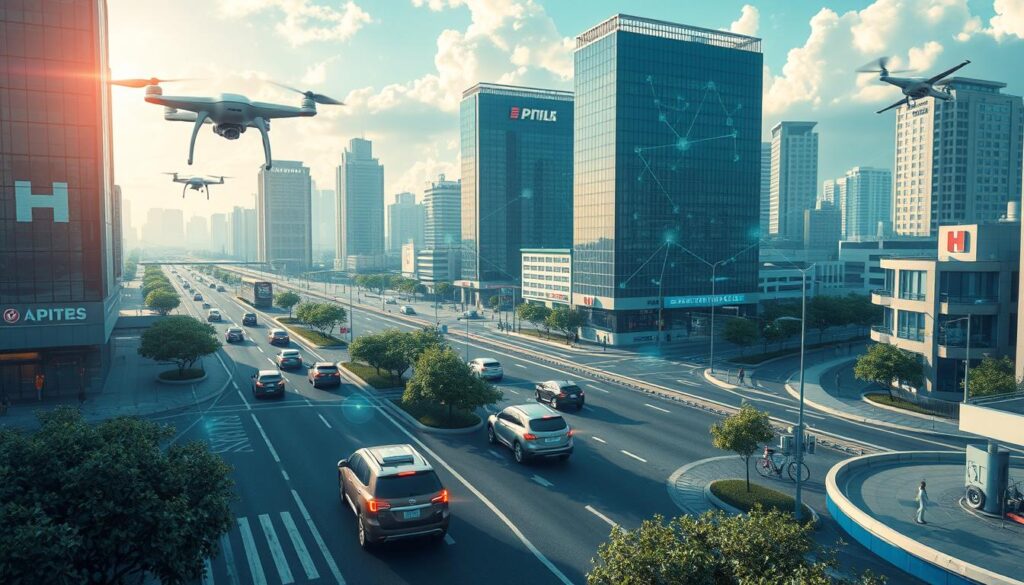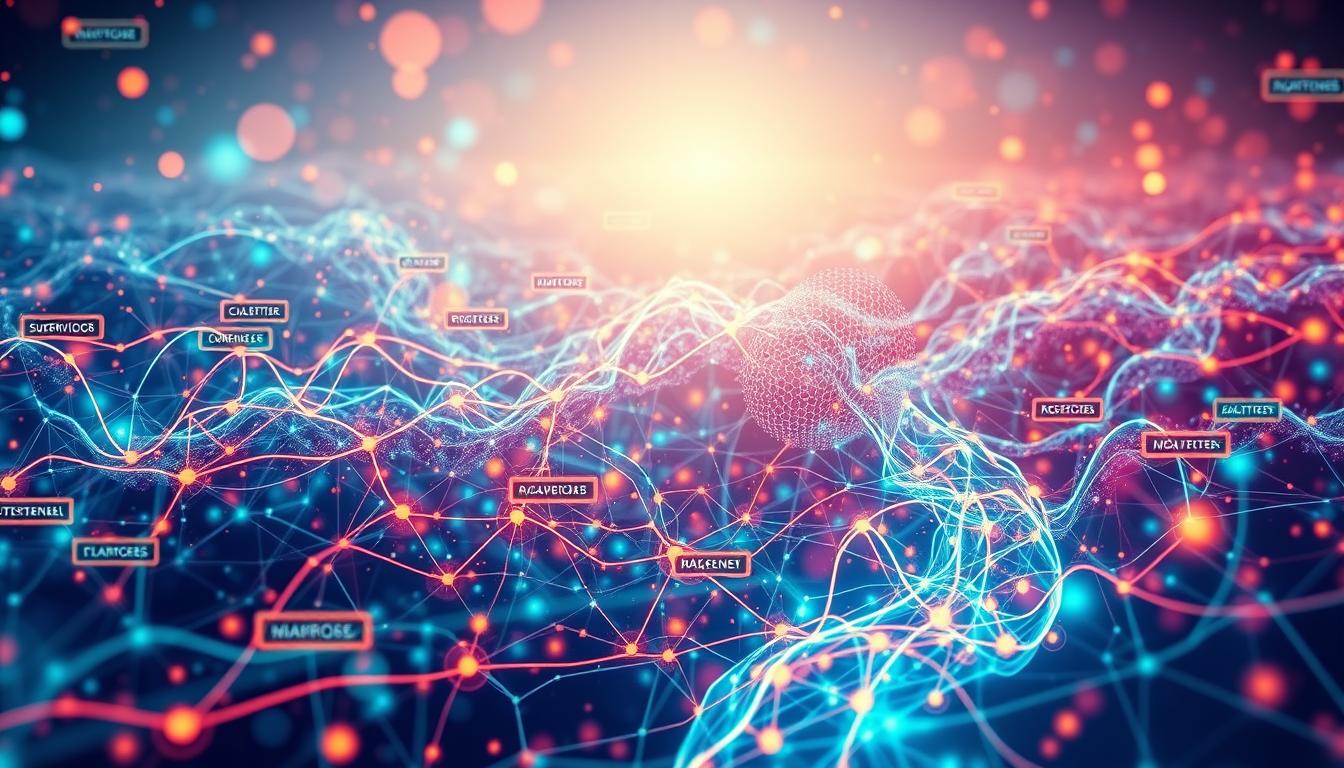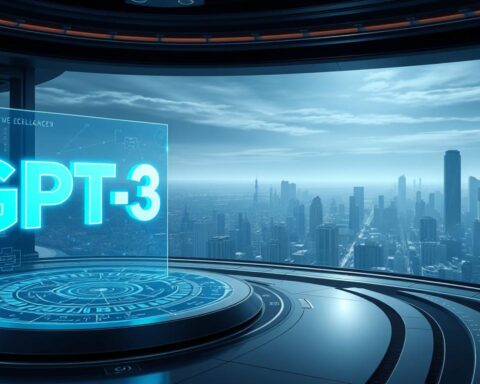Reinforcement learning is a big part of machine learning and artificial intelligence. It has made huge strides, like AlphaGo beating the world Go champion. This shows it can handle complex games well1. It’s also used in wireless communication systems, helping with big data and small-cell deployment2. The goal in RL is to get a scalar reward, which is key in wireless systems2.
Reinforcement learning is key to artificial intelligence. It lets systems learn from their surroundings and make choices based on rewards or penalties. The term “Machine Learning” was first used in 1959, a big moment in its history1. As we look into reinforcement learning, we’ll cover its basics, growth, and uses. This includes its role in wireless systems, where 74 billion devices will be connected by 20252.
Key Takeaways
- Reinforcement learning is a key aspect of machine learning and artificial intelligence.
- RL has numerous applications, including wireless communication systems.
- The desired outcome or goal of the learning in RL can be described as a scalar reward.
- Approximately 74 billion devices are projected to be connected by 2025, necessitating robust communication strategies like RL.
- Reinforcement learning enables systems to learn from their environment and make decisions based on rewards or penalties.
- RL is critical for artificial intelligence, allowing systems to adapt in complex settings.
- The term “Machine Learning” was first formally introduced in 1959, marking a significant moment in its development1.
Understanding the Fundamentals of Reinforcement Learning: Rewarding Good Moves
Reinforcement learning is a top field in machine learning, loved by the Data Science community3. It involves an agent, an environment, and actions. The goal is to get the most rewards. The agent works with the environment to reach its goal, focusing on getting more rewards over time4.
The main ideas of reward-based learning include optimization techniques and decision-making algorithms. These help the agent improve its actions. A training algorithm is also key, as it lets the agent learn from its interactions.
Reinforcement learning has three main parts: the agent, the environment, and the reward signal. The agent acts in the environment, and the reward signal tells it how it’s doing. The agent aims to get the highest total reward over time, using optimization techniques and decision-making algorithms.
- Q-Learning is a basic method in reinforcement learning. It doesn’t need a model of the environment. It checks the value of actions in different states4.
- Policy-based methods, like REINFORCE, update the policy directly based on rewards. They often need a lot of memory for big datasets4.
- Actor-Critic methods have two parts: the actor (suggests actions) and the critic (evaluates actions). They make learning more efficient4.
The Evolution of Reinforcement Learning in AI
Reinforcement learning has grown a lot over time. It started with optimal control in the late 1950s5. This idea helped create algorithms that aim to get the most rewards by acting in an environment6.
The heart of reinforcement learning is the reinforcement strategy. It uses positive reinforcement to encourage good actions. This method has helped improve many areas, like robotics, gaming, and finance6. The reinforcement model is also key, helping to make treatment plans better and more personal6.
Some big uses of reinforcement learning are:
- Teaching robots to pick up objects and move around6
- Helping self-driving cars make quick decisions based on what’s around them6
- Guiding trading plans to improve buying, selling, and holding of assets6
The growth of reinforcement learning in AI shows how powerful reinforcement strategy and positive reinforcement are. As it keeps advancing, we’ll see new and exciting uses in many fields6.
Building Blocks of Reward Mechanisms
Reinforcement learning is key in machine learning. It works because of reward mechanisms. These help artificial intelligence make choices and learn from them. The agent interacts with its environment to find the best actions7.
Creating a policy is also important. It tells the agent what to do and when. This is done using optimization techniques to get the most rewards. Thanks to machine learning and artificial intelligence, these algorithms get better7.
State and Action Spaces
The state and action spaces are key in reinforcement learning. The state space shows the current environment. The action space lists all possible actions the agent can take. Knowing these helps make better reward mechanisms and improves the system’s performance7.
Policy Development
Policy development is a big part of reinforcement learning. It’s about making rules for the agent’s decisions. Using optimization techniques and machine learning helps create policies that get the most rewards7.
Research shows reinforcement learning needs lots of data. Slow training can be a problem. But, artificial intelligence and machine learning help make training faster and more efficient7.
Designing Effective Reward Strategies
When we design reward strategies in reinforcement learning, we must think about how algorithms make decisions8. A good reward function helps the agent do what we want and avoid what we don’t want. But a bad one can cause problems, like the “paperclip problem”8. We need to pick the right training algorithm and strategy to help the agent make the best choices.
It’s important to balance sparse and dense rewards. Sparse rewards are clear but might not give enough feedback9. Dense rewards can speed up learning but might lead to bad behaviors9. Adding shaping rewards can help guide the agent towards its goals, helping it avoid getting stuck9.
To make good reward strategies, we need to think about the task’s complexity and the agent’s limitations9. Using both extrinsic and intrinsic rewards can help the agent explore and learn better9. By designing the reward function well and choosing the right training algorithm, we can make agents that learn and decide well.
The main goal is to make agents that can learn and decide in complex situations, like self-driving cars or robotics8. By using reinforcement learning and designing good reward functions, we can create agents that achieve their goals.
Implementing Reinforcement Learning Algorithms
Reinforcement learning is a key part of machine learning and artificial intelligence. It’s important for getting the best results. Q-learning is one way to do this by learning an action-value function. This function predicts the reward for a certain action in a state10.
Q-learning can be improved with reward shaping. This method gives small rewards to help the algorithm learn faster10.
Policy gradient methods are another approach. They learn a policy that maps states to actions directly. This method works well with deep learning techniques for complex problems11.
In the CartPole problem, gradient boosted trees can learn faster than neural networks11.
Potential-based reward shaping can also improve reinforcement learning. It ensures the policy will converge optimally, even with changes in the learning time10. This method works in environments like GridWorld, where the state and goal are considered10.
Implementing reinforcement learning algorithms needs a deep understanding of the principles and techniques. By using Q-learning, policy gradient methods, and deep learning, we can achieve great results in complex environments. This drives innovation in artificial intelligence and machine learning11.
| Algorithm | Environment | Result |
|---|---|---|
| Q-learning | GridWorld | Optimal policy |
| Policy Gradient | CartPole | Faster convergence |
| Deep Reinforcement Learning | Complex environments | State-of-the-art results |
reinforcement learningis a key aspect of machine learning and artificial intelligence, and its implementation is critical for achieving optimal results.
Real-World Applications and Case Studies
Reinforcement learning is used in many areas, like gaming, robotics, and finance. It helps create optimization techniques and better decision-making algorithms12. For example, DeepMind’s AlphaGo beat world champions in Go after playing millions of games12.
In robotics, reinforcement learning helps robots learn from their surroundings. This way, they get better over time13. The da Vinci Surgical System is a great example. It uses RL to help surgeons in robotic surgeries, getting more precise with each use12.
Here are some key examples of reinforcement learning in action:
- Google’s RL-driven Flu Trends system tracks flu outbreaks using search data12.
- Mount Sinai’s system personalizes insulin dosing for diabetes patients, improving glucose control12.
- Shopify uses RL to spot and stop fraud, learning from past transactions12.
These examples show how reinforcement learning can enhance decision-making algorithms and optimization techniques across different fields13. As it grows, we’ll see even more creative uses of reinforcement learning14.

For more on reinforcement learning’s applications, check out the Neptune.ai blog. It offers insights and case studies from various industries12.
Common Challenges and Solutions
Reinforcement learning works well in simulated worlds but faces hurdles in real-life use15. A key issue is the gap between setup and reality. To overcome this, a well-thought-out reinforcement strategy is needed. This strategy must account for the complexities of the physical world.
Physical systems vary greatly, from small drones to large data centers15. This shows the wide range of RL applications. A positive reinforcement method can help agents learn good behaviors. Yet, learning from few samples is a big problem in robotics, healthcare, and software15.
To tackle these issues, a reinforcement model that includes real-world constraints and uncertainties is essential.
Reinforcement learning faces challenges like balancing exploration and exploitation16. It also needs to learn efficiently from limited data16. To solve these, methods like Q-learning, policy gradients, and deep reinforcement learning are helpful16. Researchers are also looking into ways to make agents learn better, such as through transfer learning and multi-task learning16.
For more on reinforcement learning, check out this link. It covers the latest in the field.
Conclusion: The Future of Reinforcement Learning
Reinforcement learning is set to grow a lot in machine learning and artificial intelligence. It lets machines learn by doing and make better choices. This is great for things like self-driving cars17. It’s seen as a key part of machine learning, along with other types18.
Reinforcement learning has many uses, from robots to financial markets. It can even help make better trading plans17. It’s more efficient than other learning methods because it learns by doing, not just from data17. As experts keep working together, we’ll see more cool uses of it in AI and machine learning18.
Reinforcement learning is all about finding the best way to do things over time17. But, it’s not without its challenges. We need to figure out how to make it work better and balance learning with doing18. By tackling these issues, we can make the most of reinforcement learning. This will help us innovate and grow in many areas.
FAQ
What is reinforcement learning and how does it work?
Reinforcement learning is a machine learning type where an agent learns to act in an environment to get rewards. It uses algorithms to learn from trying different actions. The goal is to find the best actions to get the most rewards over time.
What are the key components of reinforcement learning systems?
Reinforcement learning systems have three main parts: the agent, the environment, and the reward signal. The agent acts in the environment and gets a reward signal. This signal helps the agent learn and improve its actions over time.
What is the role of reward functions in reinforcement learning?
Reward functions are key in reinforcement learning. They define the reward the agent gets for its actions. A good reward function encourages good actions and avoids bad ones, helping the agent learn.
How has reinforcement learning evolved in AI?
Reinforcement learning has grown a lot in AI, with new strategies and algorithms. It’s now used in many areas like robotics and finance. Deep reinforcement learning has led to top results in these fields.
What are the building blocks of reward mechanisms?
Reward mechanisms have several parts: state and action spaces, policy development, and value functions. These help the agent learn and decide in complex environments. They use AI and machine learning to improve performance.
How do you design effective reward strategies?
To design good reward strategies, you need a reward function that encourages good actions. You must understand the environment and the agent’s goals well. Using optimization and decision-making algorithms is also key.
What are some common reinforcement learning algorithms?
Common algorithms include Q-learning, policy gradient methods, and deep reinforcement learning. These use AI and machine learning to learn and improve in complex environments.
What are some real-world applications of reinforcement learning?
Reinforcement learning is used in many areas like gaming and robotics. It helps create systems that make strategic decisions and optimize performance. This includes trading algorithms that aim to maximize returns.
What are some common challenges in reinforcement learning?
Challenges include the exploration-exploitation trade-off and learning from past experiences. These need strategies and algorithms to solve. They help develop effective models for learning.
Source Links
- [FoR&AI] Machine Learning Explained – Rodney Brooks – http://rodneybrooks.com/forai-machine-learning-explained/
- Reinforcement Learning for Physical Layer Communications – https://hal.science/hal-03263888/document
- The Fundamentals of Reinforcement Learning and How to Apply It | Intel® Tiber™ AI Studio – https://cnvrg.io/reinforcement-learning/
- Mastering the Art of Reinforcement Learning: A Deep Dive for Intermediate Programmers – https://simon-bergeron.medium.com/mastering-the-art-of-reinforcement-learning-a-deep-dive-for-intermediate-programmers-4d70889d5e14
- 1.6 History of Reinforcement Learning – http://incompleteideas.net/book/ebook/node12.html
- The Evolution and Impact of Reinforcement Learning in AI – https://www.linkedin.com/pulse/evolution-impact-reinforcement-learning-ai-mohammadreza-akbari-m24sf
- SmythOS – Reinforcement Learning Basics – https://smythos.com/machine-learning/reinforcement-learning/reinforcement-learning/
- Designing reward functions: reinforcement learning | Institute and Faculty of Actuaries Blog – https://blog.actuaries.org.uk/designing-reward-functions-reinforcement-learning/
- What are the most effective reward functions for reinforcement learning? – https://www.linkedin.com/advice/0/what-most-effective-reward-functions-reinforcement-jut8c
- Reward shaping — Mastering Reinforcement Learning – https://gibberblot.github.io/rl-notes/single-agent/reward-shaping.html
- Reinforcement Learning (Q-Learning) with Decision Trees – https://towardsdatascience.com/reinforcement-learning-q-learning-with-decision-trees-ecb1215d9131
- 100+ Real-Life Examples of Reinforcement Learning And Challenges – https://www.odinschool.com/blog/top-100-reinforcement-learning-real-life-examples-and-its-challenges
- Applications of Reinforcement Learning – Real-World Examples – Plug-and-Play MLOps Platform | NimbleBox.ai – https://blog.nimblebox.ai/reinforcement-learning-applications
- Success Stories of Reinforcement Learning – https://categitau.medium.com/success-stories-of-reinforcement-learning-9b4064171668
- Challenges of real-world reinforcement learning: definitions, benchmarks and analysis – Machine Learning – https://link.springer.com/article/10.1007/s10994-021-05961-4
- Reinforcement Learning – https://kanerika.com/glossary/reinforcement-learning/
- Reinforcement learning: advantages over supervised learning – https://neuland.ai/en/news/reinforcement-learning-advantages-over-supervised-learning/
- Reinforcement Learning – Reward for Learning – https://vinodsblog.com/2018/04/16/reinforcement-learning-reward-for-learning/










